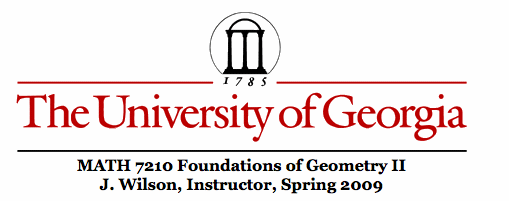

Problem Set 4.4
Problem 4.4.1
Prove that the ratio of the length of the longer side to the length of the shorter side in a triangle with angles 36, 72, and 72 is the Golden Ratio. (Hint: Bisect one of the 72 degree angles.)
Euclid called the Sublime Triangle the "Golden Triangle" and provided a construction of it in the Elements.
Problem 4.4.2
a. Given a segment AB, construct a point P on the segment that divides it into two segments such that the shorter is to the longer as the as the longer is to the whole.
See the Section 4.4 discussion. Note that this problem differs from the previous discussion.
You are asked to construct P such that
. This ratio is the reciprocal of the Golden Ratio.
b. Use the result from part (a) to give an alternative definition of the Golden Ratio.
Problem 4.4.4
An equilateral triangle is inscribed in a circle. Points M and N are midpoints of sides AC and AB, respectively, and line MN meets the circle at P and Q. Prove that MN/NQ is the golden ratio.
Problem 4.4.5
ABCDE is a regular pentagon. Sides CB and EA have been extended to meet at P. If each side of the pentagon is a units long, find BP in terms of a.
Hint: There is a sublime triangle . . . so x = a
Problem 4.4.6
Construction of a regular pentagon. Referring to the figure, prove that the following step by step construction of a regular pentagon is valid:a. Given a circle. Choose any point A on the circle and connect it to the center O.
b. Through O construct a perpendicular to OA. Let P be one of the points where the perpendicular intersects the circle.
c. Find M as midpoint of OA. Construct segment MP.
d. Construct angle bisector of Angle OMP, and let N be the point where the angle bisector meets OP.
e. At N, construct BN perpendicular to OP, B on circle. Construct BP. BP is a side of the pentagon.
f. Construct other four sides of the pentagon.
OPEN GSP FILE FOR CONSTRUCTION, ANALYSIS, AND PROOF.
Problem 4.4.7
Because we know how to construct an equilateral triangle and a regular pentagon, it is possible to construct a regular 15-gon. Explain how to accomplish the construction.
In my figure at the right, I have first constructed a regular pentagon inscribed in a circle. Then I have constructed 5 equilateral triangles with one vertex coinciding with each of the vertices of the pentagon. Notice the regular 15-gon in the center of the construction as well as the one on the outer rim.
If we reverse the order, construct an inscribed equilateral triangle and then construct three pentagons (with the same center) so that one vertex coincides with a vertex of the triangle we also get the 15-gon. There is a second 15-gon embedded in this one too
Kathy Radford has a different construction and analysis. Open her GSP file to see it.
Problem 4.4.8
Take a strip of paper, make a knot, and tighten and flatten the knot. Prove that the resulting shape is a regular pentagon.
GET READY. PAPER STRIPS WILL BE PROVIDED IN CLASS . . . MOST OF YOU WILL BE ABLE TO TIE THE KNOT. WRITING A PROOF IS THE CHALLENGE.
See GSP File for a complete proof by Mike Walliser.
The Pentagon Paper Knot -- An intuitive demonstration.
When we make these folds with a strip of paper, the 'angle of incidence' and the 'angle of reflection' will be the same.
a = b because angle of incidence equals angle of reflection.
c = a and d = b as vertical angles
But, the angles at c and at f are angles of incidence and reflection for another fold in the knot, so c = f.
Likewise, d = e. This produces a = b = c = d = e = f.That is, the external angles of the pentagon are all equal. Therefore the internal angles are each the supplement of an external angle and well all have the same measure. The pentagon is regular.
Problem 4.4.9 See GSP file for solutions to parts (a) and (b)
See GSP file for solution and discussion by Allyson Hallman
Problem 4.4.10 OMIT
Problem 4.4.11
This problem investigate the connection between the golden ratio and the Fibonacci Sequence. The Fibonacci Sequence 1, 1, 2, 3, 5, 8, 13, 21, . . . whose nth term is denoted by F(n) is defined by F(1) = 1, F(2) = 1, for n equal 3 or more, F(n) = F(n-1) + F(n-2).
Create a Spreadsheet to display F(n) in Column A for n = 1 to 25
In Column B, Beginning with Cell B2, enter the formula A1/A2 and drag down for the column. This would be the set of values for F(n)/F(n-1).
c. In your spreadsheet, compute F(n)/F(n-1)
Problem 4.4.12
Given a rectangle, cut off three triangles from the corners of the rectangle such that the three cut off triangles have the same area. Is it unique?
In both solutions, the demonstration that each of the two sides that are divided are split in the same ratio. From there then each of the splits is show to be in the Golden Ratio.
Follow-up.
1. Suppose the rectangle ABCD is a Golden Rectangle. What is the nature of the resulting center triangle?
2. What if rectangle ABCD has AB =
and BC = 1.
Problem 4.4.13 OMIT